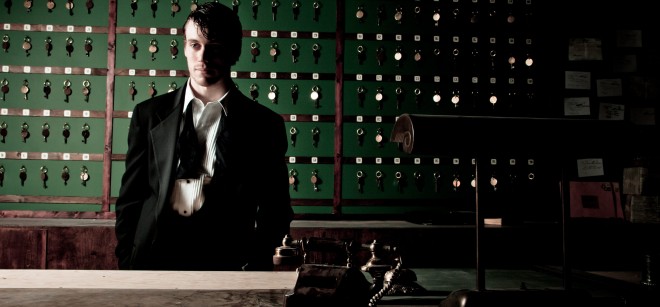‘Sleep No More’ presents Macbeth like you’ve never seen it before
An immersive Shakespeare production in a Chelsea hotel has taken New York by storm
Thom Kaine/AP
Share

I saw the orgy twice: four writhing bodies in various states of undress dancing wildly to techno music while a strobe light pulsed all around us. One fellow, naked but for a decapitated ram’s head, jumped on top of a table as the others groped each other. There was blood, a knife and, if my eyes weren’t playing tricks on me, a newborn baby. As the frenzy wound down, one of the women, a witch, stared into my eyes as she pulled her dress up over her breasts and ran down a dark staircase. I ran after her. Others followed with the discretion of stampeding elephants. She led us down a dark hallway and into a secret room with a mossy green forest full of trees, branches and a bucket of river water. As she gave herself a sponge bath, the witch gazed at me again. I stared back, mesmerized, and emboldened by my anonymity, thanks to a face mask. When she walked over to me and placed her hand on my cheek, her face was so close I thought she might kiss me. (She might have. When I later removed it, I saw what could have been a lipstick stain.) Her eyes filled with tears and her lips formed a smile. Or was it a smirk? You can never be sure with witches.
This psychosexual frolic was neither pagan fantasy nor acid trip but one of many mind-bending scenes that swallowed me whole at Sleep No More. No wonder this “immersive theatre” production based on Macbeth has taken New York by storm. Created by site-specific British theatre company Punchdrunk, Sleep No More takes place in a custom-built Chelsea venue, the McKittrick Hotel (à la Hitchcock’s Vertigo, another key Sleep No More reference) and tells its stories through movement, dance and emotions—not words.
Certainly, from dinner theatre to performance art, audience participation is nothing new. Some of Punchdrunk’s previous London productions, like The Duchess of Malfi and Goethe’s Faust, also incorporated this immersive, choose-your-own-adventure approach. However, Sleep No More takes things to a whole new level: In traditional theatre, you sit in a single space as the show moves through time. Here, many moments take place simultaneously, and you move through space to perceive them. Every audience member’s experience is unique. And the boundary between performer and audience is completely dissolved. As a result, the audience’s state of consciousness is blurred, like breaking through dream and reality; darkness and light. It’s compelling, thrilling and fun–and a unique experience for every audience member.
On arrival, guests’ coats and bags are checked and they’re then ushered into the Manderley Bar, a glamourous 1930s lounge. There’s a live jazz band and a full bar where a slinky staff (in 1930s character and costume) welcomes you. Have an absinthe shot or cocktail, or come relax here anytime you need a break from the show. Upon joining the other guests in a packed elevator, you’re given a white Venetian mask and instructions. Then the adventure really begins. As you emerge from the lift into a long, dark hallway lined with themed rooms you can enter and explore, at first it feels like a haunted house with a Broadway budget. But the more you surrender, the more real this world becomes.
Oozing film noir finesse, the massive six-storey labyrinth features more than 100 impeccably designed rooms inspired by Shakespeare’s classic tragedy. There’s a dusty hotel lobby complete with angst-ridden clerk, a banquet hall, abandoned mental hospital, huge outdoor graveyard and a haunted forest. Dozens of tiny rooms contain vintage furniture, books, love letters and wallpaper, which appeared to be printed with some secret code. One of the rooms is a candy store stocked with bonbons, some of which (if you dare sample) are quite tasty.
Yet the real highlights are the performers. They appear before you and recreate Macbeth’s key scenes through beautifully choreographed movement and dance. Violent fight scenes are fueled by passion. Each character seems to have their own narrative to work with, and I believed every moment.
While there are many ways to experience the show, one strategy is to follow a performer, especially if you want to catch the aforementioned orgy and other major events. If you’re lucky, a character will grab your hand and whisk you off. Yet just as compelling are quieter moments you discover while wandering solo: the hotel clerk manning an empty lobby, King Duncan being shaved by a servant, Macduff and his pregnant wife fighting (and making up), a young girl consulting a gypsy fortuneteller and a dancer gracefully pushing aside giant fir trees in the ballroom. The ballroom dance party that follows is captivating, too.
Along with the dim lighting, period costumes, and a score featuring music by Bernard Hermann (the famed composer who scored many Hitchcock films) all these elements converge in an avant-garde, non-linear storytelling fantasy that’s less about Macbeth’s plot and more about its vibe: Generally, the show exudes an eerie air of destruction, foreboding and regret. And specifically, scenes depict epic moments of love, jealousy and revenge—those mysteries of the human condition for which Macbeth remains so beloved. Yet Sleep No More’s most memorable appeal isn’t the sense of discovery it evokes. It’s not the thrill of the unexpected, nor the freedom of anonymity. Rather, it’s the delicious invitation to use our imaginations. As the audience surrenders to this dark world, we also touch shadowy parts of ourselves we usually fear. As in Macbeth, human nature’s dark side—and our resistance thereof—remains mysterious, seductive and ultimately relevant.
As a certain someone might say, therein lies the rub.
Sleep No More is directed by Felix Barrett, who also co-designed the space, and Maxine Doyle, who choreographed the dance. For more info, visit www.sleepnomorenyc.com